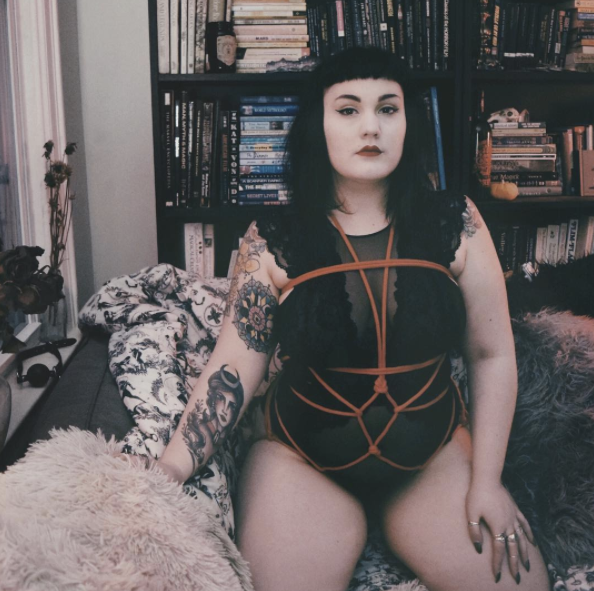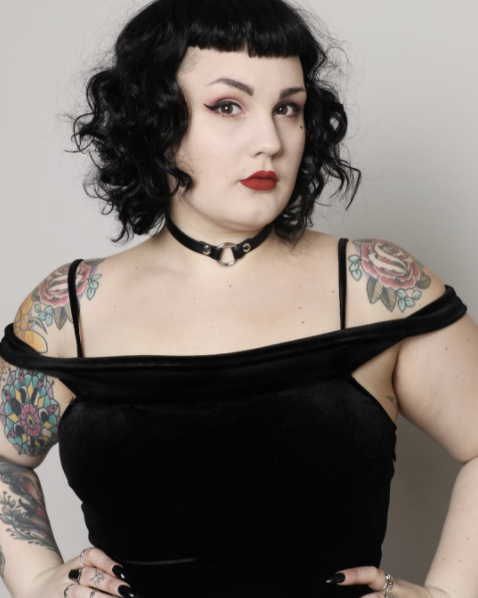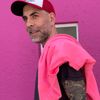Sex Heroes is an ongoing HuffPost Q&A series by Voices Editorial Director Noah Michelson that explores the lives and experiences of individuals who are challenging, and thereby changing, mainstream culture’s understanding of sex and sexuality.
Haleigh Moon is a women’s fashion buyer, the editor-in-chief of a website that endeavors to curate “every aspect of a darkly beautiful life,” and a lover of fishnets, black licorice and vegan leather.
She’s also a kink witch.
The 24-year-old, who lives in New Jersey and identifies as queer and polyamorous, combines witchcraft with kink, which, for her, often includes practicing the art of Shibari, or rope bondage, as a way of setting intentions and finding and experiencing empowerment.
I recently spoke with Moon to learn more about why and how she marries witchcraft and kink, what exactly goes into making “sexy self-love magic” and more.

HuffPost: What is a “kink witch”?
Haleigh Moon: For me, they are both terms that I identify with empowerment and a place to find a lot of self-love. Witchcraft has been a part of my life for many, many years and has become a source of finding my own power and finding my power in my place as a woman — and defining what it really means to be a woman and be a witch in my own way. A lot of that relates back to my interest in kink and sex positivity because I find a lot of empowerment through that too.
I married witchcraft to a lot of other things in my life that I find interesting. I’ve also done some work and education on using makeup and beauty as witchcraft. I use them to set intentions on a daily basis and that includes using my beauty routine as magic. That has started to relate back to kink for me. I’ve done a lot of self-love — a lot of self ties with shibari [a kind of rope bondage] to get in tune with my body and the power of having control over it.

Both of these practices and their practitioners have been stigmatized for hundreds of years.
It often goes hand in hand. Historically, many women were accused of witchcraft ― whether or not they were actually practicing it ― because they didn’t follow the rules as to how women were supposed to behave and maybe that was in a sexual context but hundreds of years ago it could have been that you just didn’t go to church enough. Now, obviously, as ideals have modernized a little bit and certain things aren’t as taboo in modern culture, sexuality is still a really demonized thing. A woman who is really proud of her sexuality and reclaims that on her own terms can be intimidating to people and demonized by people who think women shouldn’t be sexual or that it’s shameful or that women should only be sexual for men.
How did you get involved in witchcraft?
I was raised with a little bit of an introduction to it. My parents were super open about introducing us to a lot of religions. My dad was raised Catholic and my mom wasn’t raised with much religion at all. They were both hippies, so they wanted us to learn about everything so we could make decisions for ourselves about what we really connected to, so, even as a kid we celebrated Christmas, we learned about Hanukkah, and we would do a winter solstice ritual.
At the time I didn’t really even realize I was learning about witchcraft and practicing witchcraft. Then when I was about 18 and I got outside of my small town, I moved to New York City and started to get more into feminism and that really quickly linked up to witchcraft for me. The two just married together really well. I started absorbing any sources I could find — books, anything on the internet — and it just really made a lot of sense to me.
It’s about honoring divine femininity, it’s about finding your own power — my first foray into it was through Wicca, which I think a lot of people know about because it’s probably the most well-known kind of witchcraft, but I’ve since moved away from that. Since then I’ve taken little bits from everything that I’ve learned and turned it into my own practice.
Do you remember the exact moment when you decided to include kink in your practice of witchcraft?
It’s been just in the last six months or a year that I’ve started to get involved with kink outside of my personal sex life. It’s been part of my sexual relationship with my primary partner for years, and even before that, it was just a part of my sex life in general. Since then, I connected with the group of people that has become my coven and they’re all really interested in kink in many of the same ways that I am. So that’s become a really big part of the way we practice [witchcraft] together as a coven. A lot of it is just like talking about it and sharing our experiences and we find a lot of empowerment through that. Whenever we get together we pull a tarot card together and it often tends to relate back to something we’re experiencing collectively and often that has to do with sexual experiences that one or many of us are going through at the time. I think a lot of it happened when I came together with that group of people and also started exploring kink outside of my relationship and going to parties and exploring it a little bit more and really starting to live it as a more complete part of my life — including being more vocal about it, whether that’s on social media or through Babe Coven.
You said in a recent interview that on your “best night,” you’re probably “making sexy self-love magic.” For someone who has no knowledge about witchcraft or kink — or how the two work together — what does “making sexy self-love magic” actually mean?
A lot of times for me it relates back to me practicing my rope work. That’s a fairly new venture for me. In the last couple of months I’ve started teaching myself rope work and a lot of times it’s just me and my rope and I start tying myself up and I read or watch tutorials and I’m getting really in tune with my body.
It’s basically impossible to tie yourself up and not look at your body and feel your body and pay attention to what feels good and what’s working. Especially as a not-thin woman, getting in touch with the way the rope makes my body look matters because a lot of the representation out there in world of shibari involves thin women — also just in general in the world — so the way it looks on a woman who does have some curves on her, it’s very different. I look at the models I see and I say, “Oh my god, that looks so beautiful,” and then I take it and apply it to my own body and working to feel comfortable about my own body. Looking at the way the rope around my waist accentuates my waist but also might accentuate a certain roll or whatever, that’s a really magical experience for me. It feels really empowering.
What do you mean by “magical experience”?
When I say “magic” I don’t mean I’m turning something into something else — magic is working with energy. You can’t create something that isn’t there. You’re using energy and you’re manipulating energy with intention, so I’m working with the energy of my own self-love and manipulating that and working with that in a positive way and setting intentions for myself. I also work with makeup magic and the colors that I’m using have different representations for me. Purple might make me feel powerful and it’s a reminder to stand firm and it’s a very similar experience when I work with rope work. The different ties I’m doing, if I’m working with different color ropes — it all can mean different things. That’s what witchcraft is to me.
Basically the idea is that you’re manipulating energy in order to manifest whatever particular intentions you have.
Yes. Exactly. I suppose that’s a common misconception about magic. It’s not magic like in the movies. Someone might be thinking of “The Craft” and doing “glamours” and things like that but that’s not really what real witchcraft is.
But to be clear, real witchcraft does involve manifesting things into your life and putting your intentions out into the universe in order to make things happen — maybe not physically changing your appearance or conjuring a thunder storm, but the idea is that you’re using your will or energy to create things.
Yes. Absolutely.
You’ve also said you identify as both a “slut” and a “witch.” How are those two identities related?
They’re both terms that I’ve reclaimed. We touched on this a bit before but obviously witch has been used as a term to demonize women for hundreds and hundreds of years and it’s historically not a word that was used kindly to describe a woman. It’s a way to shame women. So, I’ve absolutely reclaimed that as a term that I find a lot of empowerment in my magical practice that we’ve been discussing. Slut is a very similar term, in a much more modern context. I don’t really think people are out there accusing people of witchcraft and persecuting them — at least not in this country — but women are absolutely being demonized and persecuted for being sluts. It’s an attempt to make sure that women don’t feel empowered in their sexuality. I’m not saying that every woman needs to find empowerment through sex because it’s certainly not for everybody. But I do think it’s really important that women feel it’s OK to find empowerment through posting nudes on Instagram or being really open about your sex life.
Generally speaking, it’s just about normalizing sexuality and sex for women so that they know it’s okay for them to enjoy it and to talk about it and to not think it has to be some secret, shameful thing. In finding that power and using “slut,” it really can’t be used against you. I might post a picture in my underwear on Instagram, and if someone wants to call me a slut for doing it — OK! But I’m calling myself a slut. It becomes a word that can’t really be used against you. It happens in a lot of marginalized groups and they take back those words. It doesn’t work for everybody — I definitely still have gotten feedback from women who have said “I don’t find empowerment in that term,” but that’s what it’s about: no one is going to find empowerment in any one way. When it comes down to it, woman to woman or femme to femme, it’s about not trying to police what women can find empowerment in. What works for one woman might not work for another.
What are some of the biggest misconceptions about being a kink witch?
There are definitely a lot of misconceptions about BDSM and kink. People think that it’s violent or scary or not consent-oriented when that couldn’t be further than the truth. In some ways, I think kink has been “normalized” because of things like “50 Shades Of Grey” but in an unhealthy way. People think that’s a “normalized” BDSM relationship but it absolutely is not — at all. Even through a feminist lens, people think you can’t really be feminist and kinky and that’s not true. As the submissive partner, you are the one in control and I don’t think people realize that because if you’re watching it and you don’t understand, it doesn’t really look that way. Whereas everything has been discussed and planned and consent has been clearly laid out before anything ever happens.
As far as witchcraft, people who have been involved with it for a long time and now see it being more normalized and prevalent are almost threatened by younger people defining it in their own way. I’m sure there are people who are much older than me and have been practicing witchcraft in what they see as a more traditional way who might look at me using kink or makeup or whatever I find magic in as a threat [to how they do magic] and not really understanding it and criticizing it because it’s not found a book about witchcraft but what I really connect to is that you can make witchcraft your own. You can use books as guidelines and to learn about the basics of it but then find what works for you and what you find your power in. For me, that’s kink, that’s sex, that’s makeup, that’s being femme and unapologetically so and being sexual and unapologetically so.
How does someone become a kink witch?
I do think it’s important to do your research. There is obviously a lot about both kink and magic to understand before you dive into it. Use the resources that are out there. Take what you like and work with it. Witchcraft is much more open-ended and you can figure it out for yourself. Read. Absorb. Have conversations. Talk to other witches. Learn from other witches. There’s not really a right or wrong answer to learning about witchcraft because it is so personal.
As far as learning about kink, there’s obviously a lot of safety and consent that goes into it and into learning about it. If you think you might be kinky and you want to learn about that, educating yourself is where you have to start. Learning about yourself and what you enjoy with a partner that you trust and that you can talk with openly and comfortably without any shame or discomfort — including explicit discussions of what you like and don’t like. Once you know what you like, you can turn that into a process of empowerment.
This interview has been edited and condensed for clarity.
For more information on Haleigh Moon, visit her Instagram, the official site of her coven, Babe Coven, and her online publication, Dear Darkling.
Is there a sex hero you think deserves to be covered on The Huffington Post? Send an email to Noah Michelson.


